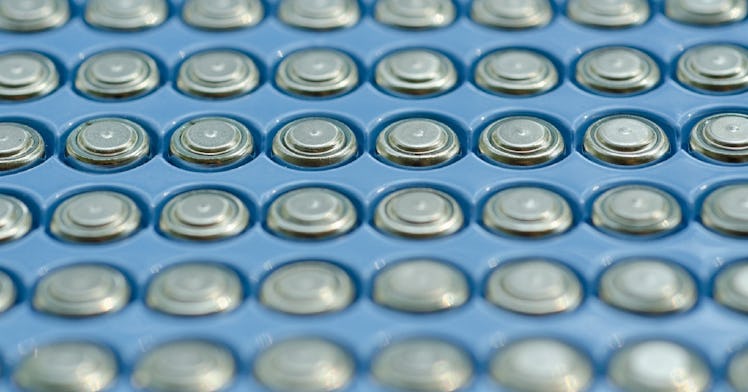Why Parents Really Do Need to Worry About Button Batteries
When ingested, they do way more harm than a bellyache.

Button batteries are small, round batteries that look like shiny buttons — and like something that a child would think is really fun to put in their mouth. Despite their size, button batteries are tremendously dangerous — more dangerous than you might think. “The stakes are so high that I encourage parents of younger children not even to purchase toys or electronics that use button battery cells,” says Christina Johns, M.D., a pediatrician and senior medical advisor at PM Pediatrics. “It’s worth it to simply avoid them altogether.” Listening? Here’s why button batteries really are that dangerous.
Why Button Batteries Are Such a Danger to Kids
Button batteries appeal to kids because they’re shiny, smooth, easy to grab, and even easier to fit inside their mouths — all reasons that make these batteries a choking hazard. But it doesn’t hugely matter whether your kid swallows a button battery or gets it lodged in their throat. That’s because the major danger with button batteries is that acid within them can ooze when the batteries become wet, like with saliva.
“The acid is highly damaging to the mucosal surface of the esophagus,” Johns says. “It happens very quickly and can cause tremendous full-thickness burns that ultimately lead to a narrowing, tightening, or scarring down the esophagus itself.” It can take years for this damage to be undone, she says.
Treating battery acid burns in the esophagus can require using a feeding tube and repeated esophageal dilations where the narrowed passages are forced open and slowly stretched. The procedure must be repeated numerous times to prevent poking or tearing holes in the esophagus, which would lead to a whole new set of health issues. “It is really quite a challenging, complicated, and risky recovery that we would like to avoid since it’s completely preventable,” Johns says.
If the button battery goes down the other pipe — the trachea, that is — it can be even more dangerous. It can get and obstruct the airway even if a kid isn’t actively choking on it. “A button battery lodged in the trachea could produce the same amount of damage from acid burns, in addition to the impact on the child’s breathing,” Johns says.
What to Do If Your Kid Ingests a Button Battery
Time is of the essence if you think your child has swallowed a button battery. Consider this to be an emergency and seek professional help immediately.
Johns recommends heading straight to the nearest emergency room so that your child can get evaluated in person. “This is not the kind of thing to wait around and wait for a call back,” she says. “When the child comes to see me in the emergency department, a stat X-ray is ordered.”
Don’t try to dislodge the button battery on your own because that can allow acid to damage a larger area of the esophagus than if it were to stay lodged in one spot. “If you have a suspicion that your child has swallowed a button battery, they shouldn’t have any food or drink. Some people think they might be able to wash the battery all the way down, but the only course of action should be to proceed directly to the emergency department.”
Although it’s possible for a button battery that’s been swallowed to make its way to the stomach without damaging the esophagus, Johns still urges parents to seek medical attention immediately because button battery acid can rapidly damage the stomach lining.
The good news is that if all of this sounds terrifying — which, yeah, it is — you can easily prevent injury from button battery ingestion from happening at home. If you use devices powered by button battery cells, keep them in their original packaging and out of reach of children until use. When it’s time to dispose of the batteries, wrap each one in electrical tape and keep them in a secure location until you’re able to take them to a participating retailer that provides battery takeback services or a local household hazardous waste collection facility, as recommended by the EPA. Because after all, the best treatment is prevention.
This article was originally published on